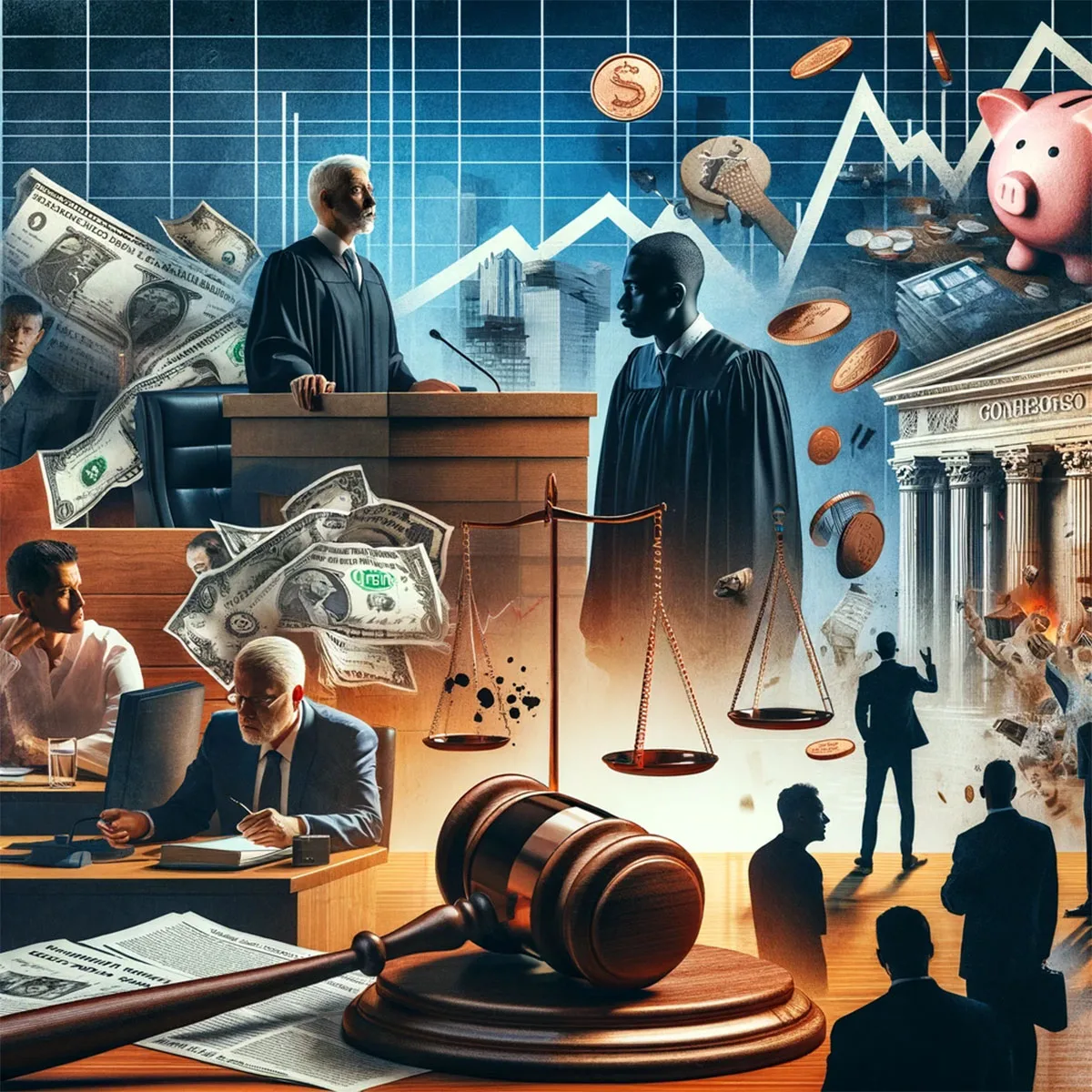In an era where financial transactions dominate our daily lives, understanding white collar crime has become increasingly important. Unlike traditional crimes, which are often visibly apparent and violent, white collar crimes are more subtle, yet their impact can be devastating. They involve deceit, concealment, or violation of trust and are not dependent on the application or threat of physical force or violence. Such crimes are committed by individuals, groups, or corporations in the course of their professional lives. From high-level executives to trusted employees, the perpetrators are typically motivated by financial gain or business advantage.
As globalization progresses and financial systems become more intricate, the relevance and complexity of white collar crimes intensify, making their understanding crucial for professionals, lawmakers, and the general public alike.
White Collar Crime Definition
White collar crime refers to a variety of non-violent crimes usually committed in commercial situations for financial gain. The term encompasses a wide range of fraudulent activities carried out by business and government professionals. The defining characteristic of these crimes lies in their basic premise; they are typically committed by individuals in a position of trust and authority, who use their position to commit fraud, embezzlement, money laundering, or other forms of deceitful financial manipulation.
Unlike blue-collar crimes, which involve more direct forms of criminal activity, white collar crimes usually involve intricate methods of concealing the illegal activities and the identities of the perpetrators, often leveraging sophisticated technologies and complex financial systems.
Historical Background of White Collar Crime
The term “white collar crime” was coined in 1939 by sociologist Edwin Sutherland, who defined it as “a crime committed by a person of respectability and high social status in the course of his occupation.” Historically, white collar crime has been associated with the affluent and powerful, often overshadowed by more violent and immediate forms of criminal behavior. However, as the 20th century progressed, the visibility and recognition of white collar crime increased. High-profile scandals and financial frauds brought these crimes into public awareness, highlighting their capacity to cause significant economic damage and societal harm. The evolution of white collar crime mirrors the transformation of modern society – moving from physical labor to a more intellectually driven economy. Over the years, as businesses and technology have evolved, so too have the methods and complexities of these crimes, making them more sophisticated and challenging to detect and prosecute.
White Collar Crime Examples
White collar crime encompasses a wide array of illegal acts, primarily characterized by deceit for financial gain. Common examples include:
- Fraud: This is perhaps the most prevalent type of white collar crime, involving deception for financial advantage. Examples include insurance fraud, credit card fraud, and securities fraud, where individuals or corporations misrepresent information for profit.
- Embezzlement: This crime occurs when a person who is entrusted with money or property appropriates it for personal use. This could be an employee siphoning funds from a company or a financial advisor misusing clients’ investments.
- Insider Trading: This is the illegal trading of a company’s securities by individuals with access to non-public, material information about the company.
- Money Laundering: This involves concealing the origins of illegally obtained money, typically by means of transfers involving foreign banks or legitimate businesses.
- Tax Evasion: Illegally avoiding paying taxes owed to the government. This can be done by individuals or corporations hiding income or inflating expenses.
- Bribery and Corruption: Offering, giving, receiving, or soliciting something of value to influence the actions of an official or other person in a position of trust.
- Ponzi Schemes: A form of fraud that lures investors and pays profits to earlier investors with funds from more recent investors.
Impact of White Collar Crime on Society and Economy
The impact of white collar crime is vast and multifaceted, affecting individuals, businesses, and the economy as a whole. Economically, these crimes can result in significant financial losses for businesses, investors, and consumers. The cost of white collar crime is estimated to be many times higher than that of blue-collar crime, affecting financial markets, reducing consumer confidence, and distorting market operations.
Socially, white collar crime undermines trust in institutions and systems essential for the functioning of society. It can lead to loss of jobs, savings, and homes, and in severe cases, can cause economic recessions. The indirect victims of these crimes include employees, customers, and general public who suffer from the corporate malpractices.
Furthermore, white collar crime can erode the moral fabric of society. When individuals in positions of power and trust engage in fraudulent activities, it sets a negative precedent and can lead to a culture of corruption and unethical behavior.
Legal Framework for Combating White Collar Crime

The legal framework to combat white collar crime includes a combination of federal and state laws, regulations, and enforcement mechanisms. Key among them are:
- The Sarbanes-Oxley Act (2002): Enacted in response to major corporate and accounting scandals, this federal law set new or enhanced standards for all U.S. public company boards, management, and public accounting firms.
- The Dodd-Frank Wall Street Reform and Consumer Protection Act (2010): This significant piece of legislation was passed in response to the financial crisis of 2008 and aims to reduce risks in the U.S. financial system.
- The Foreign Corrupt Practices Act (FCPA): It prohibits U.S. companies and individuals from bribing foreign officials for business purposes.
- Securities and Exchange Commission (SEC): The SEC enforces the regulation of the stock market and protects investors from fraud.
- Anti-Money Laundering (AML) Laws: These laws require financial institutions to monitor customers’ transactions and report suspicious activities to the government.
The enforcement of these laws often involves coordination between various agencies, including the FBI, IRS, and SEC. However, prosecuting white collar criminals can be complex due to the sophistication of the schemes, the need for specialized knowledge to understand the crimes, and the often international nature of these activities.
Prevention and Detection of White Collar Crime
Preventing and detecting white collar crime is a multifaceted effort that involves both organizational strategies and technological advancements.
- Corporate Governance and Internal Controls: Organizations must establish strong internal controls, including effective auditing processes, clear ethical guidelines, and transparent financial practices. Regular audits and financial reviews can help detect anomalies that might indicate fraudulent activities.
- Employee Education and Whistleblower Protections: Educating employees about the signs of white collar crime and encouraging a culture of integrity can be significant deterrents. Additionally, implementing strong whistleblower protections ensures that employees feel safe reporting unethical practices.
- Technology and Data Analysis: Advanced data analytics, artificial intelligence, and machine learning can identify patterns indicative of fraudulent activities. Continuous monitoring and real-time analysis can significantly reduce the time to detect and respond to white collar crimes.
- Collaboration with Law Enforcement and Regulatory Bodies: Active collaboration between corporations, law enforcement, and regulatory agencies is crucial. Sharing information and best practices can enhance the overall effectiveness of detection and prevention strategies.
High-Profile White Collar Crime Cases and Their Impact
Several high-profile white collar crime cases have had significant impacts on both law and public awareness:
- Enron Scandal (2001): This case led to the dissolution of Arthur Andersen, one of the biggest audit and accountancy partnerships in the world, and brought about the Sarbanes-Oxley Act of 2002, which imposed more stringent recordkeeping requirements on companies.
- Bernie Madoff’s Ponzi Scheme (2008): This was the largest Ponzi scheme in history, leading to significant financial losses for investors and stricter regulations for investment funds.
- Volkswagen Emissions Scandal (2015): Known as “Dieselgate”, this scandal led to massive fines for Volkswagen and raised global awareness about corporate environmental responsibility and ethics.
These cases highlight the need for stronger regulatory frameworks and more diligent corporate governance.
The Future of White Collar Crime
The future of white collar crime is likely to be shaped by advances in technology and the increasing complexity of the global financial system. Cybercrime, including cryptocurrency fraud and online identity theft, is expected to rise. Additionally, the growing interconnectedness of global markets may facilitate more sophisticated transnational white collar crimes. To combat these evolving threats, both regulatory approaches and corporate practices will need to adapt, incorporating more sophisticated technological tools and international cooperation.
Conclusion
White collar crime, with its far-reaching consequences, poses significant challenges to businesses, economies, and the moral fabric of society. Understanding its nature, staying vigilant to its evolving methods, and implementing robust prevention and detection strategies are essential in mitigating its impacts. While law enforcement and regulatory bodies play a critical role, the responsibility also lies with corporations and individuals to foster ethical practices and a culture of transparency. As the landscape of white collar crime continues to evolve, so too must our approaches to combating it.









Leave a Reply